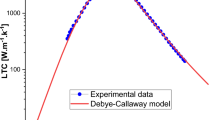Abstract
The pressure (100–200 MPa) and temperature (900–1100°C) effects on the equilibria of native point defects and background impurities in Zn-enriched ZnS are studied using cathodoluminescence and transmission spectra. The optimal conditions are found under which high pressures and temperatures accelerate migration of defects and impurities. The associated structural and compositional changes are studied by scanning electron microscopy. The increase in the concentration of dissolved oxygen at high pressures and temperatures is accompanied by a reduction in the band gap of ZnS, growth and blue shift (to 395–400 nm) of the shorter wavelength component of the SA blue emission in ZnS, and quenching of the longer wavelength component (445 nm). In addition, at 300 K a free-exciton bandI 1 emerges at 342 nm. It is shown that the data available in the literature can be used to evaluate the concentration of dissolved oxygen in ZnS · O from its band gap. The effects of different oxygen species on the transmission of ZnS are studied in the range 3.5–15 μm.
Similar content being viewed by others
REFERENCES
Rooymans, C., Structural Investigations on Some Oxides and Other Chalcogenides at Normal and Very High Pressures, Amsterdam: North-Holland, 1967. Translated under the title Strukturnye issledovaniya okislov i khal'kogenidov pri vysokikh davleniyakh, Moscow: Mir, 1969.
Morozova, N.K., Karetnikov, I.A., Plotnichenko, V.M., et al., Pressure and Temperature Effects on the Lumines-cence Centers in CVD ZnS, Fiz. Tekh. Poluprovodn. (S.-Peterburg), 2004, vol. 38, no. 1, pp. 39–43.
Morozova, N.K., Karetnikov, I.A., Blinov, V.V., and Gavrishchuk, E.M., Copper-and Oxygen-Related Lumi-nescence Centers in ZnSe, Fiz. Tekh. Poluprovodn. (S.-Peterburg), 2001, vol. 35, no. 1, pp. 25–33.
Physics and Chemistry of II-VI Compounds,Aven, M. and Prener, J.S., Eds., Amsterdam: North-Holland, 1967. Translated under the title Fizika i khimiya soedinenii A 2 B 6,Moscow: Mir, 1970.
Morozova, N.K. and Kuznetsov, V.A., Sul'fid tsinka. Poluchenie i opticheskie svoistva (Zinc Sulfide: Prepara-tion and Optical Properties), Moscow: Nauka, 1987.
Fedorchenko, O.V., Thermodynamics of Oxygen in II-VI Compounds during Chemical Analysis, Masters Thesis,Moscow: Moscow Power Engineering Inst., 1999.
Sungun, N., Jongkwang, R., Byungsung, O., and KiSeon, L., Free-Exciton Luminescence and Strain Effect of High-Quality ZnS/GaAs Epilayers, J. Korean Phys. Soc., 1998, vol. 32, no. 2, pp. 156–161.
Fok, M.V. and Golubeva, N.P., Oxygen-Related Lumi-nescence of Nominally Undoped ZnS, Zh. Prikl. Spek-trosk.,1972, vol. 17, no. 2, pp. 261–268.
Morozova, N.K., Plotnichenko, V.M., and Gavrishchuk, E.M., Absorption Spectrum of ZnO Precipitates in ZnSe, Neorg. Mater., 2003, vol. 39, no. 8, pp. 920–925 [Inorg. Mater.(Engl. Transl.), vol. 39, no. 8, pp. 78?-787].
Kroeger, F.A. and Dikhoff, J.A.M., The Function of Oxygen in ZnS Phosphors, J. Electrochem. Soc., 1952, vol. 99, no. 4, pp. 144–154.
Shan, W., Walukiewicz, W., Ager, J.W., et al., Band Anti-crossing in GaInNAs Alloys, Phys. Rev. Lett., 1999, vol. 82, no. 6, pp. 1221–1224.
Author information
Authors and Affiliations
Rights and permissions
About this article
Cite this article
Morozova, N.K., Karetnikov, I.A., Golub, K.V. et al. Pressure and Temperature Effects on Point-Defect Equilibria and Band Gap of ZnS. Inorganic Materials 40, 1138–1145 (2004). https://doi.org/10.1023/B:INMA.0000048210.15390.e1
Issue Date:
DOI: https://doi.org/10.1023/B:INMA.0000048210.15390.e1




